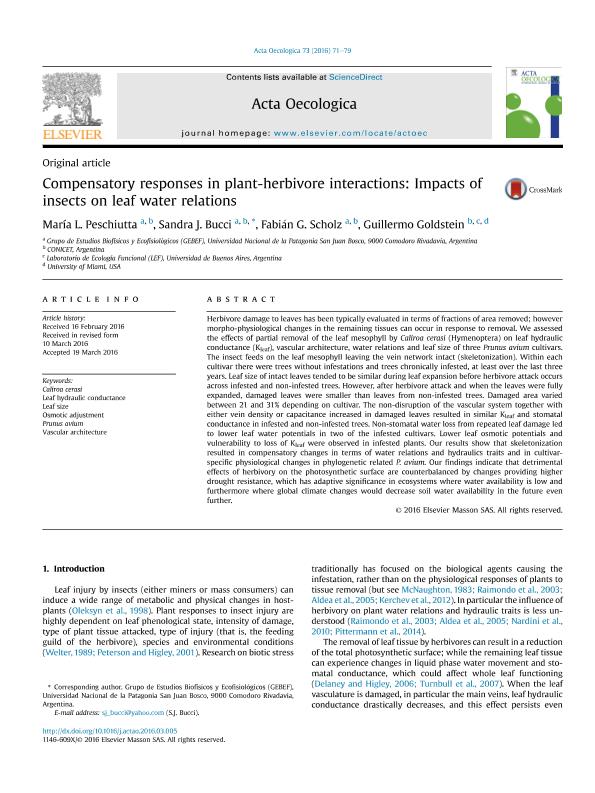Artículo
Compensatory responses in plant-herbivore interactions: Impacts of insects on leaf water relations
Peschiutta, María Laura ; Bucci, Sandra Janet
; Bucci, Sandra Janet ; Scholz, Fabian Gustavo
; Scholz, Fabian Gustavo ; Goldstein, Guillermo Hernan
; Goldstein, Guillermo Hernan
 ; Bucci, Sandra Janet
; Bucci, Sandra Janet ; Scholz, Fabian Gustavo
; Scholz, Fabian Gustavo ; Goldstein, Guillermo Hernan
; Goldstein, Guillermo Hernan
Fecha de publicación:
05/2016
Editorial:
Gauthier-villars/editions Elsevier
Revista:
Acta Oecologica
ISSN:
1146-609X
Idioma:
Inglés
Tipo de recurso:
Artículo publicado
Clasificación temática:
Resumen
Herbivore damage to leaves has been typically evaluated in terms of fractions of area removed; however morpho-physiological changes in the remaining tissues can occur in response to removal. We assessed the effects of partial removal of the leaf mesophyll by Caliroa cerasi (Hymenoptera) on leaf hydraulic conductance (Kleaf), vascular architecture, water relations and leaf size of three Prunus avium cultivars. The insect feeds on the leaf mesophyll leaving the vein network intact (skeletonization). Within each cultivar there were trees without infestations and trees chronically infested, at least over the last three years. Leaf size of intact leaves tended to be similar during leaf expansion before herbivore attack occurs across infested and non-infested trees. However, after herbivore attack and when the leaves were fully expanded, damaged leaves were smaller than leaves from non-infested trees. Damaged area varied between 21 and 31% depending on cultivar. The non-disruption of the vascular system together with either vein density or capacitance increased in damaged leaves resulted in similar Kleaf and stomatal conductance in infested and non-infested trees. Non-stomatal water loss from repeated leaf damage led to lower leaf water potentials in two of the infested cultivars. Lower leaf osmotic potentials and vulnerability to loss of Kleaf were observed in infested plants. Our results show that skeletonization resulted in compensatory changes in terms of water relations and hydraulics traits and in cultivar-specific physiological changes in phylogenetic related P. avium. Our findings indicate that detrimental effects of herbivory on the photosynthetic surface are counterbalanced by changes providing higher drought resistance, which has adaptive significance in ecosystems where water availability is low and furthermore where global climate changes would decrease soil water availability in the future even further.
Archivos asociados
Licencia
Identificadores
Colecciones
Articulos(CCT-CENPAT)
Articulos de CTRO.CIENTIFICO TECNOL.CONICET - CENPAT
Articulos de CTRO.CIENTIFICO TECNOL.CONICET - CENPAT
Articulos(IEGEBA)
Articulos de INSTITUTO DE ECOLOGIA, GENETICA Y EVOLUCION DE BS. AS
Articulos de INSTITUTO DE ECOLOGIA, GENETICA Y EVOLUCION DE BS. AS
Articulos(IMBIV)
Articulos de INST.MULTIDISCIPL.DE BIOLOGIA VEGETAL (P)
Articulos de INST.MULTIDISCIPL.DE BIOLOGIA VEGETAL (P)
Citación
Peschiutta, María Laura; Bucci, Sandra Janet; Scholz, Fabian Gustavo; Goldstein, Guillermo Hernan; Compensatory responses in plant-herbivore interactions: Impacts of insects on leaf water relations; Gauthier-villars/editions Elsevier; Acta Oecologica; 73; 5-2016; 71-79
Compartir
Altmétricas



